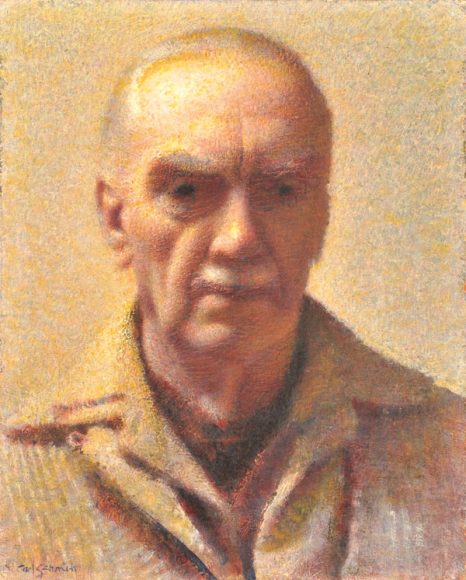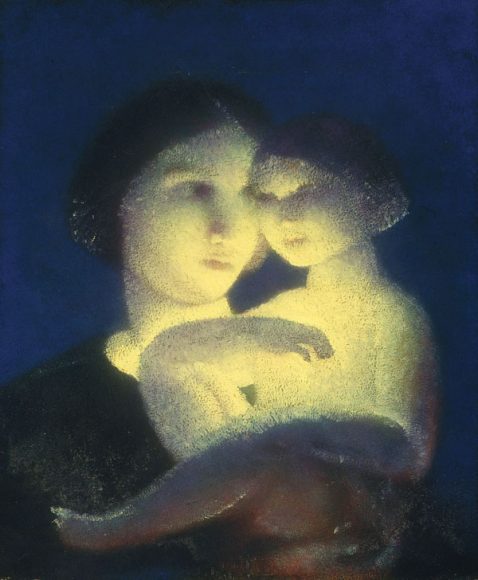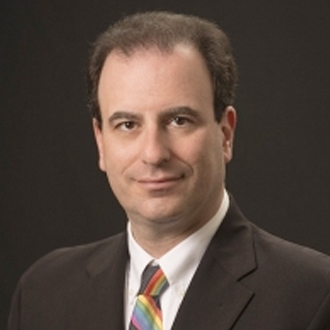When viewed from Borglum Road in Wilton’s Silvermine section, the Carl Schmitt Foundation is easy to miss — an old, somewhat down-at-the-heels, 2-story residence set back from a lopsided carport, flanked by two small and undistinguished one-room structures. And on a winter day when the trees are bare and the ground is moist from a thawed-out frost, the foundation grounds seem rather unwelcoming.
But when the doors of the three structures are opened, the visitor enters a vastly different world. Dozens of brilliantly composed paintings — some in frames, most unframed — are carefully arranged in rooms flooded with bold natural light. The paintings span a variety of styles, from neoclassicism to postimpressionism to Cubism, while the subjects range from the profundity of Jesus’ parables to the quotidian of a still life to the enigma of a portrait subject whose expression and body language offer no easy clues to its inner emotions. Andrew de Sa, the creative director and artist-in-residence at the foundation, acknowledges the versatility of Carl Schmitt’s output always comes as a surprise to those who view his creations for the first time.
“That’s what really struck me,” de Sa says. “He could have easily made a career of portraiture in New York. But he really experimented, and what is fascinating is that these aren’t from different periods. He went from this style to this style and back and forth.”
Equally amazing are the breadth of Schmitt’s artistic years. Born in Ohio in 1889, Schmitt began his studies in New York City in 1906 at The Chase School (today Parsons School of Design), where the American impressionist artist William Merritt Chase conducted classes. Schmitt continued painting until his death at the age of 100 in 1989.
Schmitt’s approach to painting was fairly unique. “He would paint one color at a time and build up from there,” de Sa says. “He would start by painting the whole canvas blue, then the next day red, and he was very systematic about it. He would have certain days when he would only paint certain colors. And he would mix beeswax with the colors. Then he would strip away and reveal the colors underneath. He is going in and patching out, so you can see the blue from the first day and the yellow from the second day.”
Also, de Sa continues, Schmitt offered a theory on the three stages of light — a lyric style that is “very flat and about patterns,” an epic stage in which “the light from without” shapes the depth of the space and an inner light that “captures the inner essence of things,” whether it is a person or an inanimate object. Coupled with diverse influences ranging from Asian prints to gothic paintings, Schmitt caught the complexity of the world through a kaleidoscope that radically changes shape and shades from canvas to canvas. De Sa notes that Schmitt’s sketchbook, which was never intended for public view, is even more astonishing.
“He was a supreme draftsman,” he says. “His pen work is just amazing. He kept endless sketchbooks. He was always drawing.”
Fame came early to Schmitt, who opened a New York City studio in 1916 and exhibited his work at major venues during the 1920s, including exhibitions at the Brooklyn Museum, the now defunct Corcoran Gallery of Art in Washington, D.C. and the Art Institute of Chicago. A reviewer exposed to Schmitt’s work at the 1926 Carnegie International exhibition in Pittsburgh dubbed him “the logical heir of the great Americans such as Homer and Eakins.” He was also a guest at the Yaddo artists’ retreat and a co-founder of the Silvermine Guild of Artists, located in the Fairfield County area that would become the home he shared with his wife Gertrude Lord, the daughter of prominent architect A.W. Lord, and their 10 children.
But the Great Depression erased Schmitt’s financial security and a bout with tuberculosis in the mid-1930s derailed his health. On the advice of doctors, he went into medical self-exile at a sanatorium in the Italian Alps, joined later by his family. War clouds, however, made a prolonged European stay impossible and he returned to his Connecticut home in 1938.
“A few patrons supported his work, but he lived with his family for most of his life in poverty,” de Sa recalls. “He always got by, sometimes barely. Today, no one really knows who he is.”
What happened that shifted Schmitt from being the toast of the art world to an obscure painter struggling to keep food on the table? According to de Sa, Schmitt had no time for self-promotion or having his works easily available for public view. His social circle consisted mostly of writers and intellectuals and not his art world peers. And his only known television interview was on a local Connecticut station later in his life. The artist forced the camera crew to shoot in the evening because he would not pause from his daylight painting hours.
Schmitt also took a harshly utilitarian view of his work. “He compared artists to peasants. He would labor and do his job, which was to paint,” de Sa says. “He understood he had to support his family, but his goal was to create these images. I don’t think he cared where they would end up.”
Indeed, de Sa is not able to offer an exact figure on Schmitt’s output. After his death, his art was divided among his 10 children. The foundation’s collection comes from donated work by two of Schmitt’s offspring. The rest of his extant work is mostly in private collections. His most famous piece, a portrait of the poet Hart Crane, is in the National Portrait Gallery in Washington, D.C.
The Carl Schmitt Foundation was established in 1996, with the initial goal of preserving the Schmitt property and making Schmitt’s artwork available through two books, “The Conscience of Beauty” and “The Vision of Beauty.” De Sa came aboard last September and coordinated the Oct. 27 symposium “Defining the Role of the Catholic Artist Today” in Washington, which brought Schmitt’s
religious art into a new view. The foundation’s collection is available for public viewing, albeit through advanced scheduling, and de Sa is now in talks with Connecticut museums to arrange a long-overdue retrospective of Schmitt’s work.
“I am passionate about getting us into a really bigger sphere,” he says. “It is a story that has not been told.”
For more, visit carlschmitt.org.






